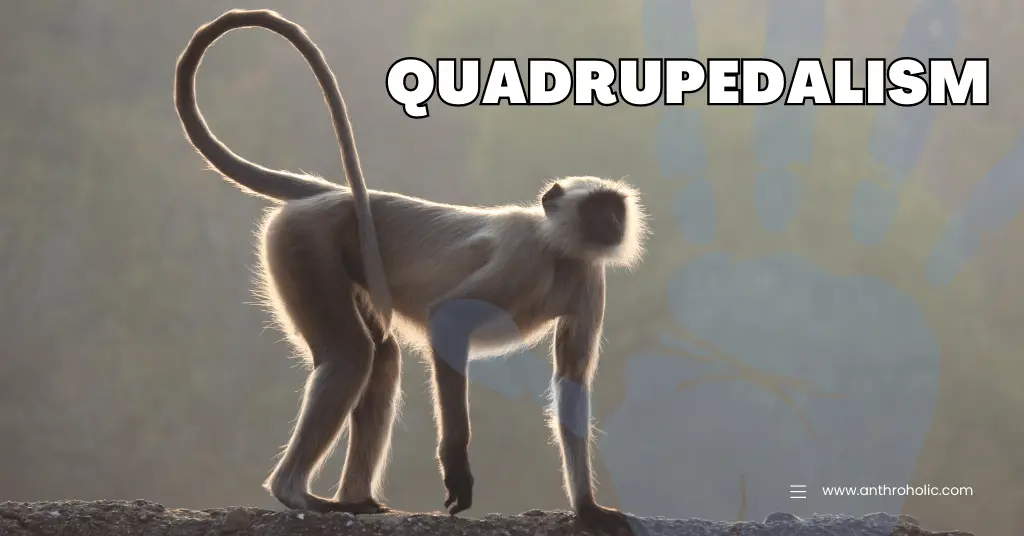AI Answer Evaluation Platform Live Now. Try Free Answer Evaluation Now
Quadrupedalism
Quadrupedalism is a type of movement in which all four limbs are employed to move around. The word Quadrupedalism is derived from two Latin words ‘quottor’ meaning four and ‘pedis’ meaning foot.

Tetrapod v. Quadruped
Tetrapod is any vertebrate which has four limbs while quadruped is an animal who walks on four legs. Tetrapods can include amphibians, reptiles, etc. It is a taxonomic unit. Not all tetrapods are quadrupeds (Maher, 2022).
Types of Quadrupedal Locomotion
There are three main types of Quadrupedal locomotion:
- Plantigrade locomotion is the most common type of quadrupedal locomotion. In this type of locomotion, the animal’s weight is supported by the entire sole of the foot. This is the type of locomotion used by most mammals, including dogs, cats, and horses.
- Digitigrade locomotion is a type of quadrupedal locomotion in which the animal’s weight is supported by the tips of its toes. This is the type of locomotion used by cats, dogs, and many other mammals.
- Unguligrade locomotion is a type of quadrupedal locomotion in which the animal’s weight is supported by the tips of its hooves. This is the type of locomotion used by horses, cows, and other hoofed mammals.
Benefits of Quadrupedal Locomotion
- Increased stability: Quadrupedal locomotion provides animals with a more stable base of support than bipedal locomotion. This is because the weight of the animal is distributed over four limbs, rather than two. This makes it less likely that the animal will fall over, especially when moving quickly or over uneven terrain.
- Increased carrying capacity: Quadrupedal locomotion allows animals to carry more weight than they could if they were bipedal. This is because the limbs are able to support more weight when they are spread out further apart. This is why animals such as horses and elephants are able to carry such large loads.
- Increased speed: Quadrupedal locomotion allows animals to move faster than they could if they were bipedal. This is because the limbs can move more efficiently when they are not supporting the weight of the animal. This is why animals such as cheetahs and greyhounds are able to run so fast.
- Increased ability to carry weight
Drawbacks of Quadrupedal Locomotion
- Reduced efficiency: Quadrupedal locomotion is less efficient than bipedal locomotion. This is because the limbs have to work harder to move the animal’s weight. This is why animals such as horses and elephants tend to tire more easily than humans.
- Reduced control: Quadrupedal locomotion can be more difficult to control than bipedal locomotion. This is because the animal has to coordinate the movement of four limbs, rather than two. This is why animals such as cats and dogs often trip and fall when they are running.
- Reduced vision and hearing: Quadrupedal locomotion can make it more difficult for animals to see and hear. This is because the limbs block the animal’s view and hearing.
Quadrupedalism and Primates
Arboreal
Slow Climbing
- Depict slow climbing.
- Strong grip with intentional movements
- Reduced index finger and thumb
- Toes have wide angles
Branch walking
- Both of the limbs i.e. forelimbs and hind limbs are of same length
- Tail used for balancing
Old world semi-brachiation
- Feature of old world monkeys
- Leaping is a prominent characteristics
New world semi-brachiation
- Feature of new world monkeys
- Prehensile tails
Terrestrial
Ground walking
- Baboons and common Patas monkey
- Equal length of limbs
Knuckle walking (Gebo, 2013)
- Chimpanzee and Gorilla
- Because of large body size
Quadrupedalism and human
Quadrupedalism, often known as being “on all fours,” is a movement that is seen when a person crawls, especially an infant (Mondschein et al., 2000). Georges Hebert popularised quadrupedal movement as a kind of physical exercise in the 20th century (Rathbone, 2022). A Japanese man named Kenichi Ito is well-known for running quickly on all four limbs.
Uner Tan Syndrome (Shapiro et al., 2014)
It is characterised by a habitual quadrupedal movement on hands and feet, dysarthric speech, cerebellar hypoplasia, and decreased cognitive function. It is a recessive genetic disorder. It is also called as syndrome of reverse evolution (Ivanenko et al., 2013).
References
- Abitbol, M. (1993). Quadrupedalism and the acquisition of bipedalism in human children. Gait & Posture, 1(4), 189–195. https://doi.org/10.1016/0966-6362(93)90045-3 . Accessed on 18 May 2023.
- Gebo, Daniel L. (2013). Primate Locomotion. Nature Education knowledge. 4.
- Ivanenko, Y. P., Wright, W. G., St George, R. J., & Gurfinkel, V. S. (2013). Trunk Orientation, Stability, and Quadrupedalism. Frontiers in Neurology, 4. https://doi.org/10.3389/fneur.2013.00020 . Accessed on 18 May 2023.
- Maher, A.E., Burin, G., Cox, P.G. et al. Body size, shape and ecology in tetrapods. Nat Commun 13, 4340 (2022). https://doi.org/10.1038/s41467-022-32028-2 . Accessed on 18 May 2023.
- Mondschein, E. S., Adolph, K. E., & Tamis-LeMonda, C. S. (2000). Gender Bias in Mothers’ Expectations about Infant Crawling. Journal of Experimental Child Psychology, 77(4), 304–316. https://doi.org/10.1006/jecp.2000.2597 . Accessed on 18 May 2023.
- Primate Locomotion | Learn Science at Scitable. (n.d.). https://www.nature.com/scitable/knowledge/library/primate-locomotion-105284696/ . Accessed on 18 May 2023.
- Rathbone, K. (2022). Sport and physical culture in Occupied France: Authoritarianism, agency, and everyday life. Manchester University Press.
- Rose, MD. (1973). Quadrupedalism in Primates. Primates 14, 337 -357. https://doi.org/10.1007/BF01731356 . Accessed on 18 May 2023.
- Shapiro, L. J., Cole, W. G., Young, J. T., Raichlen, D. A., Robinson, S. K., & Adolph, K. E. (2014). Human Quadrupeds, Primate Quadrupedalism, and Uner Tan Syndrome. PLOS ONE, 9(7), e101758. https://doi.org/10.1371/journal.pone.0101758 . Accessed on 18 May 2023.




